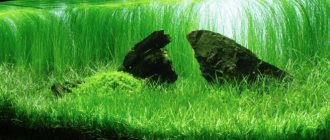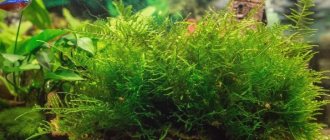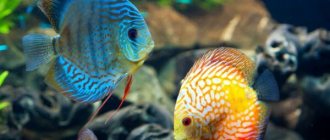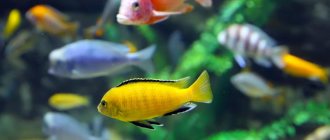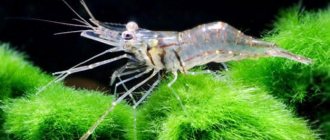An aquarium is not just a piece of furniture, but also a harmonious environment that requires the care and attention of its owners. Part of caring for a container with small fish involves planting various aquarium plants. There are several hundred plants actively used aquarists to create a unique underwater world. Among them, it is worth highlighting Schisandra - an interesting plant that is especially popular. More details about keeping Schisandra in the aquarium will be discussed in this article.
Schisandra
Description
The lemongrass plant, which has a pleasant citrus aroma, is often called swampweed. It grows well in fresh water.
The plant has a straight and elastic stem. The sheets have characteristic features:
- Silvery shade on the back side, greenish on the front side.
- Shape: oval with a slight point.
- All veins are clearly visible.
- Length – 120 mm, height – 300 mm, width – 30 mm.
Schisandra grows quickly in a standard aquarium. Therefore, its height often exceeds the height of the tank. Leaves that appear out of water are distinguished by their roughness and relief.
Schisandra is used not only for the aquarium. It is used to create a paludarium that combines air and water environments.
See what lemongrass looks like in an aquarium.
Maintenance and care of the aquarium plant Schisandra
Under optimal conditions, Nomaphyla grows all year round and reaches the surface of the aquarium. Therefore, to grow it, it is recommended to choose a vessel at least 55 cm high. It is best to plant lemongrass in large-volume aquariums, and it will be able to grow to its maximum size and come to the surface.
A warm-water tropical aquarium is optimal for nomaphila. The plant loves warmth very much, so the water temperature is required in the range from 22 to 28 degrees. A lower temperature will certainly lead to the growth of lemongrass stopping and the leaves becoming smaller.
The conditions for keeping the aquarium plant Schisandra require bright lighting. It should grow directly under a powerful lamp and then the nomaphila leaves will be healthy and rich in color. As soon as it becomes too dark for the plant, the lemongrass will become paler and smaller. The approximate power of the lamps is from 0.5 W/1l. volume of water. The duration of illumination is twelve hours.
For the growth of nomaphila, nutritious soil with the addition of silt, clay, and charcoal is required. The thickness of the soil is at least 5 cm for rooting the stem.
When keeping such a plant in an aquarium, you need to change a fifth of the water every week. For lemongrass, water hardness plays an important role - it must be at least 8 ° C; soft water is not suitable for the plant and its leaves begin to collapse.
It is recommended to renew Nomafila at least twice a year . It propagates by simple cuttings. Shoots of approximately 7 centimeters are separated, planted in the ground and they quickly take root. This ensures good growth, the plant begins to bush even more and produce new cuttings. It is recommended to plant it in a group.
Little tricks for growing plants and propagating them
- It is recommended to plant all varieties of Nomafil in a group. To make them grow faster, you can shorten the stem.
- A tall plant that has reached the surface of the aquarium may shed its remaining leaves under water.
- Cuttings are an easy way to propagate lemongrass. Young roots and leaves appear on the mother plant. They are separated by cutting off the top of the adult by approximately 7 cm. The shoots are planted in previously prepared soil.
- An adult lemongrass does not suffer at all from this procedure.
It begins to bush even more and forms new cuttings. When growing a tropical guest in an aquarium, you should pay attention to: - Lighting.
- Soil properties.
- Water.
- Feeding.
Temperature conditions.
Schisandra does not tolerate cold. The ideal temperature for it is from 22 to 280 C.
The plant is suitable for a soft or medium-hard water environment. It must be clean. Once a week, the water is partially changed (up to 30% of the liquid volume).
Nomafile needs intense lighting. The duration of her daylight hours is 12 hours. It is recommended to select fluorescent lamps so that for every 1 liter of volume there is 0.5 W of their power.
Schisandra loves direct sunlight.
The plant will like it if you place the aquarium on the windowsill or as close to the window as possible. Incandescent lamps create additional side lighting. Such a lighting system will allow you to preserve old leaves for a long time.
Soil requirements:
- Sufficient concentration of nutrients, a lot of sludge.
- The thickness of the soil layer at the bottom of the aquarium is 5-7 cm.
- When transplanting nomaphila, clay is placed under the roots.
- The nature of the substrate itself does not play a big role, since the plant has strong roots.
- Schisandra is very sensitive to changes in the environment. A sharp disturbance of living conditions can cause illness. Considering this, you should not get carried away with fertilizing.
- Nomafil reacts especially hard to high concentrations of sodium ions. Baking soda and table salt are added to water with great care.
The plant will actively develop in the paludarium and greenhouse. Much faster than in an aquarium. It immediately grows in a low container filled with water. After the formation of aerial shoots, the lemongrass is transplanted into the soil.
You can take a cutting from a nomaphila grown in this way and transplant it into an aquarium. The shoot easily adapts to new conditions and will continue to develop. Armed with the necessary knowledge, it is easy to create ideal conditions for growing fish in your aquarium.
Reproduction
Nomafila propagates using cuttings. To get new lemongrass, aquarists cut off the upper shoots of the flower and plant them in the substrate, thus propagating one specimen. In order for the sprout to take root, feel good, and develop, a piece of clay is placed under the roots, or the shoot is planted in a clay pot, thus preventing the risk of fish digging up the flower.
There is another way to propagate nomaphila. A young twig, cut from the top of the plant, is left to float on the surface of the water surface. True, in the case of such breeding, the lemongrass leaves will be twisted, as they will actively reach for the light, and this can no longer be corrected. Cutting off nomafile sprouts does not harm, but on the contrary, increases its growth and splendor.
Schisandra is a beautiful ornamental plant that will transform and decorate any artificial pond. Caring for nomaphila is not difficult: the flower with a citrus aroma is responsive, easily reproduces and brings great benefits to the inhabitants of the aquarium. Under good conditions, lemongrass will bloom with lilac flowers and delight its owner.
Kinds
There are a large number of varieties of aquarium lemongrass known, but only some species are used to decorate a home aquarium. These include several varieties of the plant.
- Narrow-leaved. The main distinguishing feature of this plant is its highest growth rate compared to other species. Please note that in fairly soft water environments this species may shed its leaves and the stem will be bare on the top few layers. The plant also loves a lot of light, replacing a small amount of water in the aquarium (1-2 times a week).
- Dwarf. This type of aquarium lemongrass is distinguished by its rather short epicotyls and very dense foliage, which is located close to each other. It is also worth noting that this type of aquarium plant is beginning to gain popularity among aquarium enthusiasts.
- Willow leaf. It is considered one of the most unusual species, since the same species can look completely different depending on the location. Features include a thin and flexible stem, as well as narrow and very thin leaves that are able to wriggle along with the flow. The plant loves bright light and does not tolerate liquid forms of fertilizer. In addition, this variety can serve as an indicator of the aquatic environment, you just need to pay attention to the change in the foliage of the plant: white bloom – iron deficiency; yellowing or rapid death - lack of nitrates; holes in the foliage - lack of calcium.
Habitat
Under natural conditions, lemongrass is found in water bodies of Southeast Asia. This species loves shallow waters, but can also grow along the coast of larger lakes and ponds. This is a semi-aquatic crop that thrives in both water and air.
Nomaphyla leaves are arranged crosswise and give the impression of a regular geometric pattern.
In aquariums, nomaphila grows year-round, actively and quickly. High aesthetic values make this representative of the aquatic flora a favorite among other aquarium crops. Especially considering the ease and simplicity of care.
How to choose?
In order to create a beautiful and comfortable aquarium for your fish, some part of its perimeter should be occupied by algae. They will help create a beautiful look. Unlike artificial vegetation, live aquarium plants will provide benefits to your pets.
The choice of aquarium algae should be approached with due care. And lemongrass is no exception. To begin with, it is worth noting that algae for an aquarium can be divided into 3 categories according to their location: in the back, in the middle and in front of the aquarium.
Schisandra can usually be found either in the middle part or in the background of the aquarium (depending on the species).
To choose a good “seedling” for your aquarium, you should pay attention to several external signs. These include several factors.
- The stem should be a darker color compared to the foliage. And also it should not be too thin.
- The leaves should look healthy, without any plaque or blotches. Their color is usually slightly lighter than the stem. Depending on the plant variety, the back of the leaves may be a different color from the front, but this may not always be a bad sign.
- The roots must be at least 2-3 centimeters so that the plant can take root well in the soil of the aquarium. Make sure that the roots are without any damage.
What are the benefits of lemongrass?
Thai lemongrass is used in aquariums for its decorative properties. After all, the plant is distinguished by its density and elegance.
Algae is planted in a tank for another reason. They act as a filter that eliminates organic matter and the remains of the vital activity of individuals. They saturate the container with oxygen and remove remaining carbon dioxide.
Life cycle
Experienced aquarists note that with proper care, life expectancy can be measured in decades. This is due to the continuous cycle of reproduction.
Algae growth is the same throughout the year. After all, lemongrass “does not hibernate.”
Compatibility with the “residents” of the aquarium
Experienced aquarists do not plant lemongrass in tanks with ancistrus and cleaners. After all, these fish actively absorb the foliage of these plants.
Nomaphyla is planted in containers with other algae and shady plants. You should not plant them with those species that require shortened daylight hours. After all, this provokes a deterioration in appearance.
Schisandra is characterized by active growth. Therefore, it spreads throughout the tank, and other plants begin to rot and stop growing. The solution is simple - growth control, periodic pruning of “adult” plants, transplanting into other tanks and containers.
Algae should not be planted in close proximity to other plant varieties, decorative elements and driftwood.
Algae are not planted in tanks in which pistia grows. After all, pistia prevents their growth.
Diseases and treatment
Spots and other damage to algae appear due to the fact that the balance of key parameters is disrupted.
Problems and solutions
- The temperature of the aquarium water decreases. This provokes stunting of growth and deterioration of the leaves. Sometimes spots appear.
- Lack of light. When using a low-power lamp, the vegetation becomes less lush. Therefore, before installing a lighting device, experienced aquarists carry out calculations. This allows you to set the optimal power of the fluorescent lamp.
- Lack of rigidity. Specks are formed at reduced rigidity parameters. If the required balance of hardness is not restored, then the lemongrass is completely destroyed.
- Lack of substrate. Spots do not form with a thin layer of soil. The development of algae stops.
Spots are not the only sign of the disease. The absence of flowers also indicates non-compliance with the rules of care.
When diseased, the dark stem becomes lighter and becomes covered with microcracks. Therefore, periodic inspection is an important step in caring for this plant.
To create a harmonious environment in the aquarium, a responsible approach to the choice of vegetation is required. And lemongrass is the best option for small and large containers with fish. After all, it is compatible with many phenotypes and representatives of the fauna. Its planting is carried out without complex preparatory processes.
Diseases
With proper care, nomaphila blooms and pleases the eye, and there are no spots or growths on the leaves and stems. If conditions are violated, the plant becomes ill, as evidenced by the following signs:
- loss of integrity of leaves and small spots on them - the reason lies in too soft water;
- large dark spots – low water temperature; poor development and fragility - small thickness of the substrate;
- light or pale yellow spots – magnesium deficiency;
- leaves turn yellow and change shape, curling - lack of potassium;
- dying leaves - lack of lighting or too soft water;
- discoloration and purple spots on the leaves are a lack of nutrients.
To prevent the plant from getting sick, aquarists additionally feed the flower by adding mineral fertilizers to the water. Without these nutrients, lemongrass loses its beauty and develops poorly. The main signs that nomaphile does not have enough attention and care are spots on the stem and leaves, as well as the absence of blue flowers.
Interesting fact: to prevent lemongrass from growing too much and interfering with other types of flora, it is planted in a small pot, thus controlling the roots.
Common varieties
Serious competitors of ordinary lemongrass are Nomafila serrata and Nomaphila thailandica. They are often the choice of discerning aquarists:
- Toothed algae has leaves with a sparser arrangement, on the edges of which there are pointed formations. Because of this feature, the plant does not require a lot of bright light. The leaves of Schisandra angustifolia, located in the upper part, do not create a strong shadow, so the lower branches receive enough light.
- The Thai variety always looks elegant in an aquarium. It is distinguished by small leaves that densely cover the stem. The general shape of this algae is very similar to a branched and lush shrub.
Direct nomaphilia diseases
As already mentioned, lemongrass is a rather capricious plant and if the favorable environment is disturbed, it may experience various growth deviations and even diseases. Let's look at some of them.
So, with poor lighting, a rapid death of vegetation is observed, and in the absence of any restoration measures, soon only a bare stem with a huge amount of fallen dense vegetation at the bottom can be observed. Another negative factor is the presence of too soft water, which has a destructive effect on the greenery of the plant. It is also impossible not to say about the thin level of soil, which will be the main reason for the poor development of the plant.
In addition, to maintain the appearance of nomaphila in ideal condition, it is recommended to carry out rejuvenating procedures at least once every 6 months. This is necessary for the appearance of small shoots with small leaves on the plant. And most importantly, being in an unhealthy state, lemongrass will not be able to bloom, which will deprive any aquarist of the opportunity to see the incredibly beautiful picture of the appearance of bluish-lilac flowers above the surface of the water.
Reviews
The experience of aquarists varies greatly: for some, Schisandra grows very quickly, which is the reason for abandoning the plant, for others, nomaphila does not take root or grows very slowly.
The combination of lemongrass in an aquarium with floating plants creates an impressive decorative effect. Nomaphyla is common in Dutch-style aquariums. This plant is often confused with hygrophila.
Next
Plants Hemianthus micranthemoides is a long-stemmed freshwater plant
Difficulty in content
If favorable conditions are created for lemongrass, then it begins to grow extremely quickly, increasing the green mass with such force that it can quickly occupy the entire territory of the aquarium (aquarists often complain about this on Internet forums). To take control of the process, experts recommend planting plants not in the ground, but in a small clay pot. It will not allow the root system to develop too rapidly, and this will somewhat slow down the activity of the green part of the plants.
ATTENTION: a pot for lemongrass that is too large can cause the plant to slow down in growth for a long period of time - its main activity will be focused on growing the root system, and not the green part. By the way, periodic “haircuts” are very necessary for plants.
Thanks to it, side shoots grow, which adds lushness and beauty to the lemongrass.
By the way, periodic “haircuts” are very necessary for plants. Thanks to it, side shoots grow, which adds lushness and beauty to the lemongrass.
Compatibility with other aquarium inhabitants
Among the active inhabitants of the aquarium, Schisandra has one enemy - the Ancistrus fish (it is also called the sticky catfish, the cleaner catfish). This fish is not averse to eating the delicate foliage of the plant, which spoils its appearance.
But among plants, lemongrass has almost no enemies. Unless he, a tropical representative, would have to adapt to the Spartan living conditions that are pleasant to some other plant. But a caring owner usually selects representatives of flora and fauna with the same set of requirements, so that no one is disadvantaged.
The problem may be one thing: an overly active lemongrass will take over the entire living space of the “glass house”, not giving other plants the opportunity to fully develop. The solution is to control the growth of the “invader” by performing regular pruning. In addition, experts do not recommend planting plants very close to each other; moreover, it is necessary to separate each green pet with a stone or snag.
ATTENTION: if there is a Pistia in the aquarium (its rosette leaves drift along the surface of the water), you need to make sure that it does not grow, otherwise the lemongrass will not be able to escape, and this is important for it.
Diseases, their treatment and prevention
Schisandra gets sick if the comfortable environment to which it has adapted is disrupted. Changed coloration and stunted growth indicate that problems have arisen. What are the causes and consequences of the disease:
- low temperature - the stem does not grow, the leaves are fragile and small;
- soft water - plants are destroyed;
- a thin layer of soil insufficient for roots - the plant develops poorly;
- little light - leaves die, starting from the lower ones;
- lack of nutrients in the water - leaves change color.
ATTENTION: if Schisandra is sick, it will not bloom, and you will not have a chance to watch this wonderful phenomenon.
Lifespan
The lifespan of aquarium lemongrass is difficult to limit to any period of time. “In the hands” of a caring owner who provides his green pet with proper care, we can talk about a continuous cycle, a kind of continuity, when plants replace each other without losing their freshness and decorativeness. An important point: for lemongrass there is no change of seasons, periods of “oppression” or “hibernation” - it grows the same way all year round. In addition, it is very active - sometimes it gives a weekly increase of up to ten centimeters.
Average price and where to buy
You can buy lemongrass online on almost all sites that offer aquarium plants for sale: lemongrass is not a rare representative of underwater flora. You can buy it in the form of a separate branch (100 - 150 rubles per branch 10 centimeters long) or in a pot (plant length - up to 15 centimeters), then it can cost up to 720 rubles. Examples of sites that carry out sales are www.aqua-tver.ru, dennerle-plant.ru.
Pruning rosette plants
The most popular representatives of this type in the aquarium hobby are Cryptocorynes and Echinodorus. Their stem is very short and turns into a compact main root, like a rhizome, only small, hidden behind a dense bunch of smaller roots. The leaves are very densely located at the tip of the stem, forming a leaf rosette. Each new leaf grows from its center. New daughter rosettes are formed on the miniature rhizome of the rosette. They can be carefully separated and planted as an independent plant.
The central part, the one with the root and stem, is the most important part of the plant and should not be damaged when pruning. You can even remove all the roots and leaves from it and a renewed plant will appear from it in nutritious soil.
Accordingly, the leaves can be safely cut off with scissors when they become too large or are spoiled by algae or herbivorous fish. The cut leaf is removed; a new plant will not grow from it.
Some species, such as Vallisneria dwarf, look like “carpet” plants. They can also be trimmed, since removing each small leaf individually is too painstaking work. Leaves cut in this way usually die, but new ones quickly appear from the rosette instead.
Vallisneria reproduces by numerous lateral shoots connected to the mother plant by long arrows. To separate a new sprout, just trim the arrow.
Tips for aquarists and interesting facts
- The plant develops much faster in the air.
- If the lemongrass grows above the aquarium's limits, it may begin to shed its submerged leaves because it believes it has fulfilled its "water duty."
- Plant growth accelerates if its stem is constantly shortened.
- An adult aquarium lemongrass has such a strong stem that it is difficult to break it with your hands.
It is worth noting that the natural habitat of lemongrass is the south-eastern part of Asia. It grows as a marsh species on the banks of large bodies of water, and as a semi-aquatic species it is found in small bodies of water.
Nowadays, it is quite easy to acquire lemongrass by any means - buy in a specialized store, borrow from friends, or exchange with other aquarists. It can be sold either as a separate branch or in a pot.
You just need to show attention and care, then the plant will respond and delight you with its beauty and rapid growth.
The benefits of lemongrass for the aquarium
When discussing the merits of any aquatic plant, it is customary to consider culture from two positions: aesthetics and pragmatics. In terms of aesthetics, nomaphila enjoys well-deserved respect among aquarists. As for pragmatism, the advantages are the following features of this plant:
- Schisandra is a natural biofilter. Aquatic culture effectively cleanses the water area from waste products of living organisms.
- This culture actively absorbs CO2 (carbon dioxide), enriching the aquatic environment with the necessary oxygen.
- Luxurious dense vegetation provides good shelter for many aquarium inhabitants.
It is recommended to plant lemongrass in jars containing fish that require protection and prefer privacy.
Compatibility with aquarium inhabitants
Among the huge assortment of fish, shrimp, aquarium crayfish and crabs, lemongrass has only one “enemy”.
This is a sticky or cleaner catfish (Ancitrus). The catfish loves to feast on nomaphila leaves, which causes great damage to the decorative qualities of the plant.
Schisandra has no enemies among the plant representatives of the aquatic area. But it is worth taking into account the active growth of this plant, which can literally occupy the aquarium space and certain requirements for water parameters.
Not every aquatic culture adheres to exactly these criteria.
Do not plant crops of other species too close to lemongrass. Better yet, separate them with decorative accessories (driftwood, stone, etc.).
- Any type of aquatic plants that feel comfortable in the conditions required by lemongrass can be planted in a container with lemongrass.
- And species like Pistia (whose leaves drift along the water surface) must be treated carefully, preventing them from growing.
- Otherwise, lemongrass will not have access to the surface of the water - and for this species it is very important to grow not only in the water layers, but also above them.
